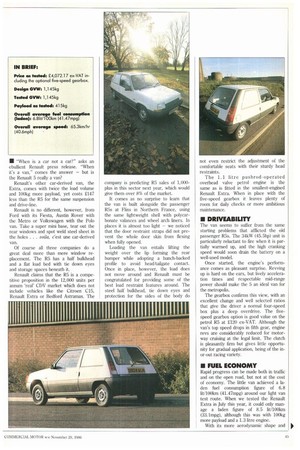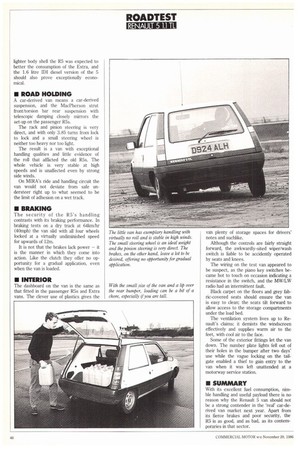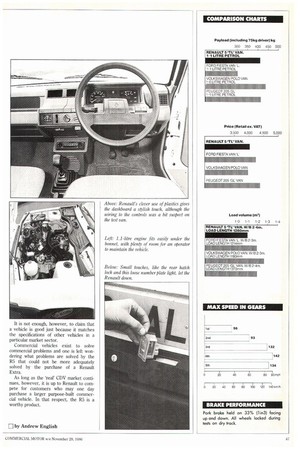• "When is a car not a car?" asks an
Page 47

Page 48

Page 49

If you've noticed an error in this article please click here to report it so we can fix it.
ebullient Renault press release. "When it's a van," comes the answer — but is the Renault 5 really a van?
Renault's other car-derived van, the Extra, comes with twice the load volume and 100kg more payload, yet costs £147 less than the R5 for the same suspension and drive-line.
Renault is no different, however, from Ford with its Fiesta, Austin Rover with the Metro or Volkswagen with the Polo van. Take a super mini base, tear out the rear windows and spot weld steel sheet in the holes . . voila, c'est une car-derived van.
Of course all three companies do a great deal more than mere window replacement. The R5 has a half bulkhead and a flat load bed with tie down eyes and storage spaces beneath it Renault claims that the R5 is a competitive proposition in the 12,000 units per annum 'real' CDV market which does not include vehicles like the Citroen C15, Renault Extra or Bedford Astramax. The company is predicting R5 sales of 1,000plus in this sector next year, which would give them over 8% of the market.
It comes as no surprise to learn that the van is built alongside the passenger R5s at Flins in Northern France, using the same lightweight shell with polycarbonate valances and wheel arch liners. In places it is almost too light — we noticed that the door restraint straps did not prevent the whole door skin from flexing when fully opened.
Loading the van entails lifting the weight over the lip forming the rear bumper while adopting a hunch-backed profile to avoid head/tailgate contact. Once in place, however, the load does not move around and Renault must be congratulated for providing some of the best load restraint features around. The steel half bulkhead, tie down eyes and protection ft r the sides of the body do not even restrict the adjustment of the comfortable seats with their sturdy head restraints.
The 1.1 litre pushrod-operated overhead valve petrol engine is the same as is fitted in the smallest-engined Renault Extra. When in place with the five-speed gearbox it leaves plenty of room for daily checks or more ambitious maintenance.
• DRII/FABILITY
The van seems to suffer from the same starting problems that afflicted the old passenger R5s. The 34kW (45.5hp) unit is particularly reluctant to fire when it is partially warmed up, and the high cranking speed would soon drain the battery on a well-used model.
Once started, the engine's performance comes as pleasant surprise. Revving up is hard on the ears, but lively acceleration times and respectable mid-range power should make the 5 an ideal van for the metropolis.
The gearbox confirms this view, with an excellent change and well selected ratios that give the driver a normal four-speed box plus a deep overdrive. The fivespeed gearbox option is good value on the petrol R5 at £120 ex-VAT. Although the van's top speed drops in fifth gear, engine revs are considerably reduced for motorway cruising at the legal limit. The clutch is pleasantly firm but gives little opportunity for gradual application, being of the inor-out racing variety.
• FUEL ECONOMY
Rapid progress can be made both in traffic and on the open road, but not at the cost of economy. The little van achieved a laden fuel consumption figure of 6.8 lit/100km (41.47mpg) around our light van test route. When we tested the Renault Extra in July this year, it could only manage a laden figure of 8.5 lit/100kin (33.1mpg), although this was with 100kg more payload and a 1.3 litre engine.
With its more aerodynamic shape and lighter body shell the R5 was expected to better the consumption of the Extra, and the 1.6 litre ID1 diesel version of the 5 should also prove exceptionally economical.
• ROAD HOLDING
A car-derived van means a car-derived suspension, and the MacPherson strut front/torsion bar rear suspension with telescopic damping closely mirrors the set-up on the passenger R5s.
The rack and pinion steering is very direct, and with only 3.85 turns from lock to lock and a small steering wheel is neither too heavy nor too light.
The result is a van with exceptional handling qualities and little evidence of the roll that afflicted the old R5s. The whole vehicle is very stable at high speeds and is unaffected even by strong side winds.
On MIRA's ride and handling circuit the van would not deviate from safe understeer right up to what seemed to be the limit of adhesion on a wet track.
• BRAKING
The security of the R5's handling contrasts with its braking performance. In braking tests on a dry track at 64km/hr (40mph) the van slid with all four wheels locked at a virtually undiminished speed for upwards of 12m.
It is not that the brakes lack power — it is the manner in which they come into action. Like the clutch they offer no opportunity for a gradual application, even when the van is loaded.
• INTERIOR
The dashboard on the van is the same as that fitted in the passenger R5s and Extra vans. The clever use of plastics gives the With the small size of the van and a lip over the rear bumper, loading can be a bit of a chore, especially ffyou are tall. van plenty of storage spaces for drivers' notes and suchlike.
Although the controls are fairly straight forward, the awkwardly-sited wiper/wash switch is liable to be accidently operated by seats and knees.
The wiring on the test van appeared to be suspect, as the piano key switches became hot to touch on occasion indicating a resistance in the switch, and the MW/LW radio had an intermittent fault.
Black carpet on the floors and grey fabric-covered seats should ensure the van is easy to clean; the seats tilt forward to allow access to the storage compartments under the load bed.
The ventilation system lives up to Renault's claims; it demists the windscreen effectively and supplies warm air to the feet, with cool air to the face.
Some of the exterior fittings let the van down. The number plate lights fell out of their holes in the bumper after two days' use while the vague locking on the tailgate enabled a thief to gain entry to the van when it was left unattended at a motorway service station.
• SUMMARY
With its excellent fuel consumption, nimble handling and useful payload there is no reason why the Renault 5 van should not be a strong contender in the 'real' car-derived van market next year. Apart from its fierce brakes and poor security, the R5 is as good, and as bad, as its contemporaries in that sector. It is not enough, however, to claim that a vehicle is good just because it matches the specifications of other vehicles in a particular market sector.
Commercial vehicles exist to solve commercial problems and one is left wondering what problems are solved by the R5 that could not be more adequately solved by the purchase of a Renault Extra.
As long as the 'real' CDV market continues, however, it is up to Renault to compete for customers who may one day purchase a larger purpose-built commercial vehicle. In that respect, the R5 is a worthy product.
























































































































